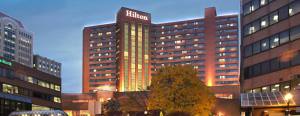The concept of redeveloping what was known as the Ten Eyck Hotel site was launched in 1972 and was hailed as a collaboration between the public and private sectors in an effort to revitalize a stagnant business district. It was championed by public officials such as Mayor Erastus Corning and Gov. Nelson Rockefeller, and was part of a larger urban renewal plan that sought not only to develop Albany’s downtown but also provide jobs for local working class residents.
When completed in 1980, the Albany Hilton became the city’s only major hotel in the neighborhood. The $18 million, 400-room hotel completed the redevelopment of Ten Eyck Plaza, a $45 million project that included a bank, a parking garage, an office tower, a commercial arcade and a public park. The project was spearheaded by Rockefeller, who wanted to provide guests with acceptable accommodations, and Corning, who pushed for the demolition of the Ten Eyck Hotel and convinced the governor to include office and retail space as part of the complex. It was financed in part by a federal Urban Development Action Grant to the City of Albany, which was then loaned to the developers of the Hotel as a second mortgage. Built on property owned by a subsidiary of the State’s Urban Development Corp, the project benefited from an agreed-upon schedule of tax abatements and exemptions.
Subsequently known as the Omni Albany when Servico declared bankruptcy in 1990, the hotel was turned into the Crowne Plaza Albany nine years later as part of a $10 million renovation project by Lodgian Inc., an Atlanta-based company that specializes in upgrades and renovations.

Today, the hotel is known as the Hilton Albany, changing its name once again after the completion of a $14 million renovation earlier this year. Improvements to the 34-year old building included newly decorated rooms, wireless Internet, updated in-room entertainment systems and a new lobby restaurant, lounge and check-in.
As a new associate at Herrick, Feinstein in 1978, Leonard Grunstein represented the developers of the project, a partnership between a public hotel company and private development firm. Within this role, he negotiated the financeable ground lease with the UDC, helped craft and negotiate the leasehold financing structure for the first mortgage and the UDAG second mortgage, and dealt with the many problems that had to be solved associated with a project of this scale. This included such arcane matters as navigating the City’s and State’s laws in order to obtain a liquor license at the Hotel. Grunstein also helped obtain and negotiate the terms of the Urban Development Action Grant, which enabled the project’s fruition.

